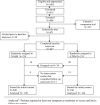Response analysis for multiple symptoms revealed differences between arms of a symptom management trial
- PMID: 19124223
- PMCID: PMC2743381
- DOI: 10.1016/j.jclinepi.2008.09.007
Response analysis for multiple symptoms revealed differences between arms of a symptom management trial
Abstract
Objective: To describe the methodology of evaluating the response of cancer patients to interventions directed at lowering severity of multiple symptoms, and to compare two arms of a symptom management trial to determine factors associated with response and time to response.
Study design and setting: Randomized trial comparing a nurse-assisted symptom management (NASM) cognitive-behavioral intervention with an automated telephone symptom management (ATSM). Patients in both arms received six intervention contacts over 8 weeks. Analyses of the intervention contact data for 190 patients in NASM arm and 164 patients in the ATSM arm were conducted. Severities of 15 cancer-related symptoms were assessed at each intervention contact, and an anchor-based definition of response was adopted. Analyses were carried out using generalized estimating equations and Cox marginal proportional hazard models.
Results: When compared with patients in the NASM, patients in the ATSM had better response to manage anxiety, depression, poor appetite, cough, and fatigue. NASM was more successful in managing cancer pain. Response and time to response were associated with several patient and disease characteristics.
Conclusion: The approach described here presents an analytic and clinical improvement over methods that examine each symptom separately or use summed scores of severity.
References
-
- Miaskowski C. Symptom clusters: establishing the link between clinical practice and symptom management research. Support Care Cancer. 2006;14:792–794. - PubMed
-
- Miaskowski C, Dodd M, Lee K. Symptom clusters: the new frontier in symptom management research. J NCI Monographs. 2004;32:17–21. - PubMed
-
- Chang V, Thaler H, Polyak T, Kornblith A, et al. Quality of Life and Survival: The role of multidimensional symptom assessment. Cancer. 1998;83:173–179. - PubMed
-
- Mendoza T, Wang X, Cleeland C, Morrisey M, et al. The rapid assessment of fatigue severity in cancer patients: Use of the brief fatigue inventory. Cancer. 1999;85:1186–1196. - PubMed
-
- Curt G, Breitbart W, Cella D, Groopman J, Horning S, Itri L, Johnson D, Miaskowski C, Scherr S, Portenoy R, Vogelzang N. Impact of cancer-related fatigue on the lives of patients: New findings from the Fatigue Coalition. Oncologist. 2000;5(5):353–360. - PubMed
Publication types
MeSH terms
Grants and funding
LinkOut - more resources
Full Text Sources


